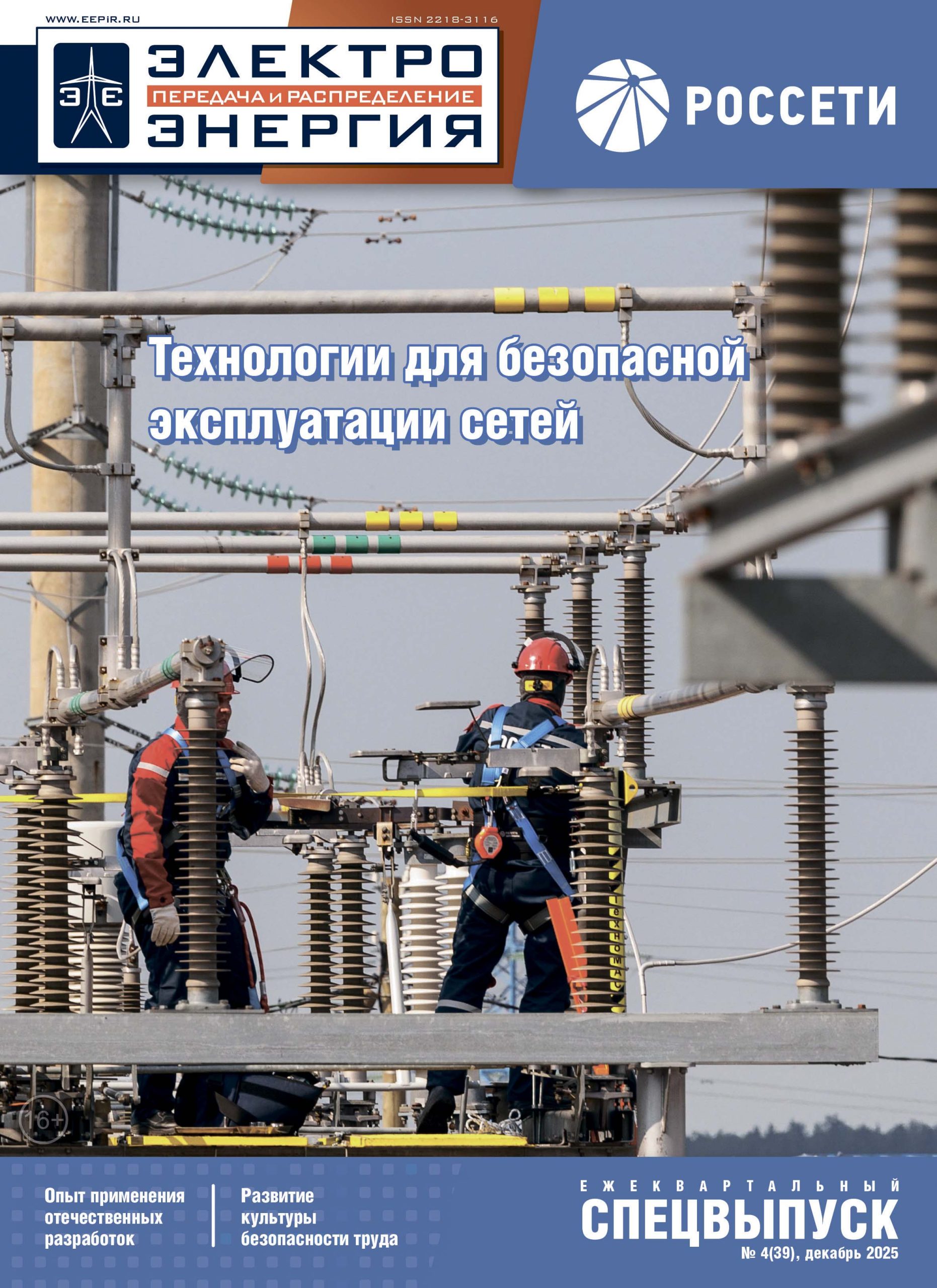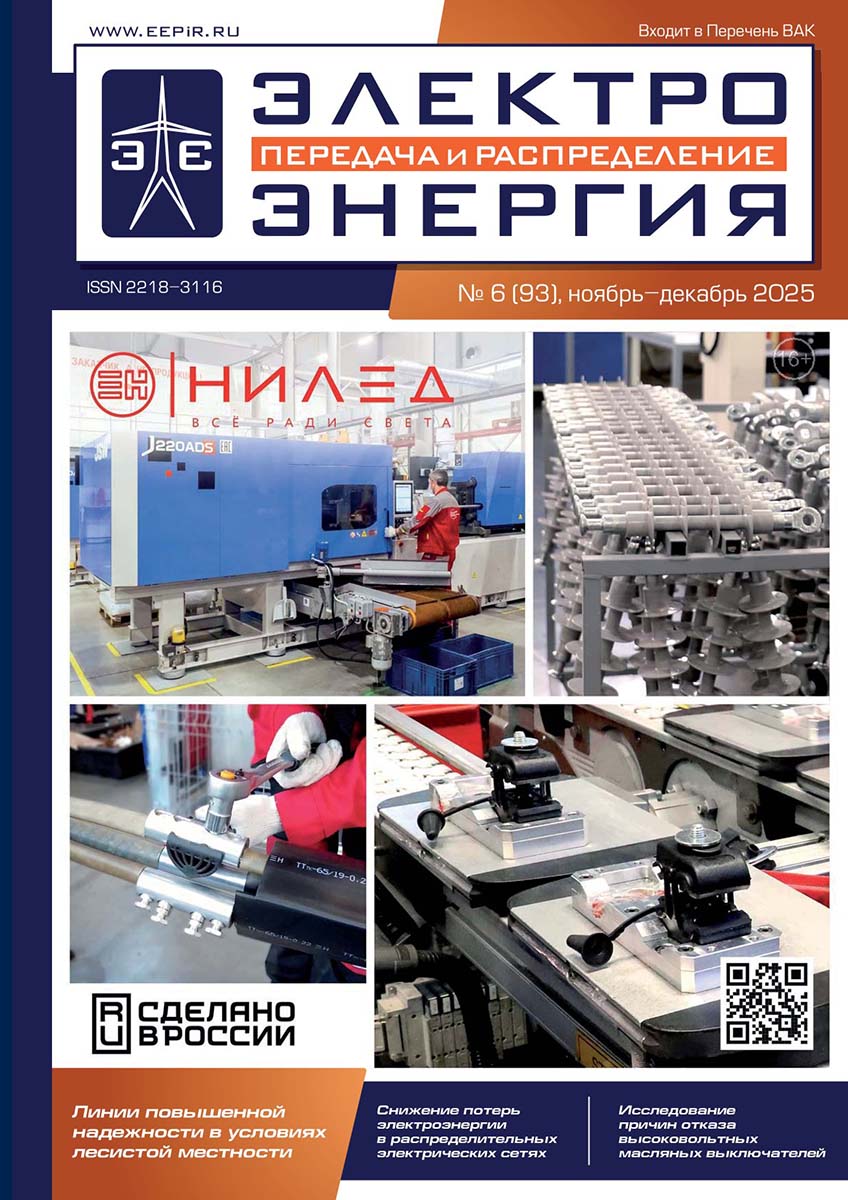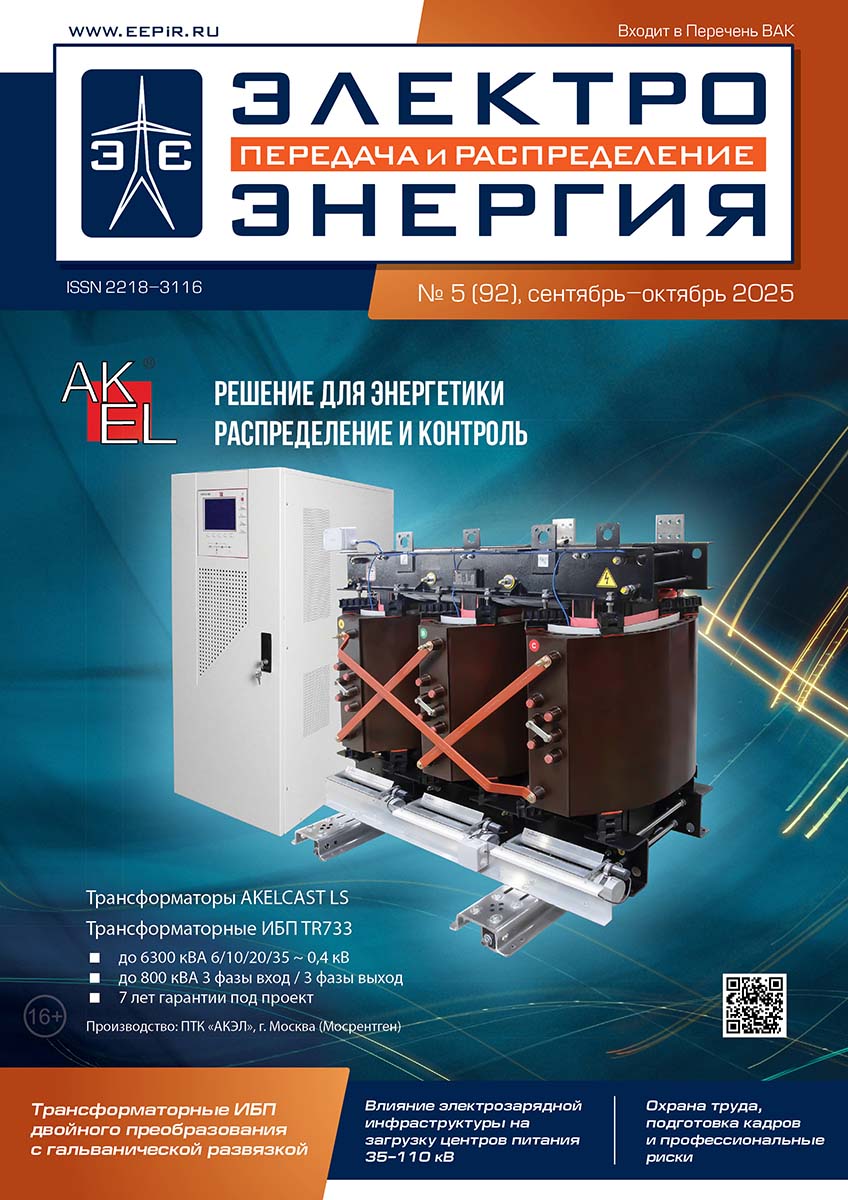
25 августа 2022
«ЭЛЕКТРОЭНЕРГИЯ. Передача и распределение» № 4(73), июль-август 2022
СОБЫТИЯ
ЭНЕРГОСБЕРЕЖЕНИЕ
ЭНЕРГОСБЕРЕЖЕНИЕ
ВОЗОБНОВЛЯЕМАЯ ЭНЕРГЕТИКА
КАЧЕСТВО ЭЛЕКТРОЭНЕРГИИ
ВОЗДУШНЫЕ ЛИНИИ
КАБЕЛЬНЫЕ ЛИНИИ
РЕЛЕЙНАЯ ЗАЩИТА И АВТОМАТИКА
ОБОРУДОВАНИЕ
ОБОРУДОВАНИЕ
ДИАГНОСТИКА И МОНИТОРИНГ
ОХРАНА ТРУДА
ОХРАНА ТРУДА
ОХРАНА ТРУДА
EVENTS
VII International Scientific and Technical Conference «Development and Reliability Improvement of Distribution Networks»
Review
ENERGY SAVING
Technological Sovereignty in Russian Power Industry: Energyefficient Transformers with Amorphous-Steel Cores
OOO NPK AVTOPRIBOR
Development of the Procedure of Precise Actual Load Estimation of 6(10)–0,4 kV Transformers by Using the Data Obtained from Smart Energy Metering Systems
Musaev T.A., Khabibulin M.N., Shageev S.R. (JSC Grid Company), Fedorov O.V. (NNSTU n.a. R.E. Alekseev)
Abstract. The results of investigation intended for development of the procedure of precise estimation of 6 (10)-0,4 kV power transformer actual load with the help of the data obtained from smart energy metering systems are presented in this article. Today, estimation of the transformer load is made by determining the subscribed demand and by the test day results; it leads to considerable overestimation of the load factor and, therefore, incorrect conclusion about the need to install or replace the transformer by a more powerful one. Another consequence is increase of technical energy losses and reduction of transmission and distribution efficiency. The developed procedure enables precise estimation of the actual transformer load factor, correct technical decision about the need to replace or install a more powerful transformer. This leads to increased loading of lightly-loaded transformers, reduction of technical losses and improved efficiency of transmission and distribution processes.
Keywords: energy losses, power transformer load References: on page
RENEWABLE ENERGY
Automatic Control of Active Power Output of Wind Power Plants under Congested Grids Conditions
Tsydenov E.A., Prokhorov A.V. (National Research Tomsk Polytechnic University)
Abstract. The paper discusses the limitations of existing automatic generation control systems that appear under impact of variable energy resources such as wind and solar power plants. To overcome identified issues, the authors proposed an approach that advances power flow control selectivity and flexibility by means of online intelligent computation of plant participation factors. The approach considers the estimation of participation factors as an optimization task which can be solved in online mode to distribute AGC control action between governed power plants in accordance with their characteristics and actual information about power system state. To implement the proposed approach, the authors developed a software tool which interacts with a real-time database and a component for power flow calculations that allows refreshing of plant participation factors based on actual telemetry information. The corresponding optimization models were established to perform conventional and advanced control strategies which are useful in grids with limited transfer capability. To meet performance requirements imposed by variable energy resources, the machine learning model − the densely connected neural network, was designed for power flow estimations. Besides, Lasso regression method was proposed to select the features relevant for the considered control tasks and improve the performance of the machine learning based power flow estimation. The proposed approaches were experimentally tested, and the results confirmed their applicability in existing automatic generation control systems.
Keywords: automatic generation control, dimensionality reduction, machine learning, neural network, participation factor, power flow analysis, renewable energy, wind power station
References: on page 36.
POWER QUALITY
Modeling of Non-Sinusoidal and Unbalanced Modes of a Real Electric Network Providing Power Supply of Traction Consumers
Bordadyn P.A., Marinov Ya.A., Shish K.V., Silaev M.A. (NRU MPEI)
Abstract. The paper is devoted to the study of voltage non-sinusoidality and unbalance in electrical networks providing power supply of the traction load. Dynamic modeling of non-sinusoidal and unbalance modes of Trans-Baikal Railway electrical network section has been carried out. A software package based on a simulation model of the network section in MATLAB Simulink has been developed. The developed software is intended for evaluating the impact of electrified railways on power quality (PQ) in terms of voltage non-sinusoidality and unbalance (including intermittent voltage unbalance) depending on the schedule and power of trains, the profile of the railway, network parameters and other initial data.
Keywords: power quality, electrified railways, non-sinusoidal voltage, voltage unbalance
References: on page 44.
OVERHEAD TRANSMISSION LINES
Image of Ice Melting Scheme
Zasypkin A.S., Shchurov A.N. (SRSPU (NPI)
Abstract. It is proposed to estimate the efficiency of ice-melting diagrams (IMD) by discrete correlation between the ice wall thickness melted by IMD in 60 minutes and the air temperature and the wind velocity within the range of their possible variation. Ice-melting time and ice-free section wire temperature are defined by the image. It is recommended to use the image in ice-melting programs instead of the melting time values when two weather condition combinations are available and the ice coupling thickness is set. The IMD image is supplementary information for the dispatcher.
Keywords: overhead power line, ice melting scheme, image of ice melting scheme
References: on page 48.
JSC Energy+21: Mastering of New Products is Completed
Unified Pedestals in Present-day Overhead Line Projects. Requirements to Protective Concrete Layer Thickness
PO Energozhelezobetoninvest, LLC, NIIZHB n.a. A.A.Gvozdev
CABLE LINES
Heat-resistant Tubes ProtectorFlex® are the First to be Tested by PJSC Rosseti
Energotek Company
«Review of Manufacturers, Suppliers and the Market of 6-35 kV Cable Joints in Russia»: Review of the Paper
Feedback
RELAY PROTECTION AND AUTOMATION
Analysis of the Possibility of Using Recurrent Neural Networks to Determine the Setpoint of Operation of Long-Range Redundancy Protections
Akhmedova O.O., Soshinov A.G., Atrashenko O.S. (Kamyshin Institute of Technology (branch) of the Volgograd state technical university)
Abstract. The reliability of the operation of overhead power transmission lines largely depends on precisely selected operating settings of relay protection systems. The parameters of power transmission lines change throughout the year and relay protection devices must change the setpoints according to the real indicators of overhead lines. According to the authors, the use of recurrent neural networks in relay protection systems opens up broad prospects for the adaptation of trigger settings. This will increase the sensitivity of long-range redundancy protections and make short-term forecasts for changes in the current passing through the overhead power line in operating and emergency modes.
Keywords: relay protection, actuation settings, parameters of an overhead power line, recurrent neural networks
References: on page 71.
EQUIPMENT
About Repairs of 220-500 kV Switchgear Equipment in Tie Substations and Their Diagrams
Grinev N.V. (Branch of «Rosseti FGC UES» – MES of the Urals, Yekaterinburg)
Abstract. Current maintenance performance of 220- 500 kV switchgear components has been obtained. It was shown that introduction of SF6 breakers has lessened the idling time of switchgear bays in the power system in general, however the achieved performance is insufficient for simplification of main diagrams and bypass busbar systems.
Keywords: switchgear, electrical connection diagram, HV equipment repair
References: on page 77.
Innovative Solutions of OOO ENERGOPROM-AL’YANS for Digital Distribution Power Stations in Conditions of Technological Sovereignty
FIRE SAFETY
The Fire Can be Avoided
JSC Ekotekh
DIAGNOSTICS AND MONITORING
ACEMS Data-Based Identification of Actual Transformer Parameters
Omorov T.T., Takyrbashev B.K. (National Academy of Sciences of the Kyrgyz Republic, Bishkek), Suerkulov M.A., Imanakunova Zh.S. (Kyrgyz State Technical University n.a. I. Razzakova, Bishkek), Zholdoshov T.M. (Osh State University, Kyrgyzstan)
Abstract. Estimation of actual values of internal impedance (parameters) of the transformer that supplies a 0,4 kV distribution network with the capacity up to 2500 kVA is considered in this article. The method and the algorithm based on the data obtained from the head three-phase energy meter included into the automated commercial energy metering system (ACEMS) are proposed. The system of algebraic equations in reference to initial transformer parameters has been obtained. It is solved by using the numerical algorithm of embedded criterial function minimization. This method and its algorithm can be used for diagnosis of transformer parameters and solving the tasks of distribution network operating mode optimization and energy loss monitoring within ACEMS.
Keywords: transformer parameters, parameter identification, identification method
References: on page 86.
LABOR PROTECTION
Newest Protection Means. Smart Technologies
Event overview
Arrangement of 6-10 kV Live Work Training for PJSC Rosseti Moscow Region Personnel
Comprehensive Solutions for Providing the Work-at-Height Safety and Training of Grid Personnel
OOO Carabelli Srl, OOO TEMZ
Study of Application of Auxiliary «Wave» Guide Components in Rigid Anchor Lines at 35 kV and Higher Overhead Lines
VNII truda of the Ministry of Labour of Russia
INDUSTRIAL INJURIES
Lessons Learned from Accidents
Russian Federal Service for Ecological, Technical and Atomic Supervision
GLOBAL EXPERIENCE
CIRED Porto Workshop 2022 E-mobility and Power Distribution Systems
Review
GUEST of the ISSUE
Towards Innovations
JSC UNECO










